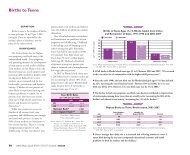2010 Rhode Island Kids Count Factbook
2010 Rhode Island Kids Count Factbook
2010 Rhode Island Kids Count Factbook
Create successful ePaper yourself
Turn your PDF publications into a flip-book with our unique Google optimized e-Paper software.
Secure Parental Employment<br />
DEFINITION<br />
Secure parental employment is the<br />
percentage of children living with at<br />
least one parent who has full-time,<br />
year-round employment.<br />
SIGNIFICANCE<br />
Secure parental employment<br />
increases family income and reduces<br />
poverty. Children with parents who<br />
have steady employment are more likely<br />
to have access to health care. Secure<br />
parental employment is also likely to<br />
improve family functioning by reducing<br />
the stress brought on by unemployment<br />
and underemployment of parents. 1<br />
Among poor families, children with<br />
working parents are less likely to repeat<br />
a grade or be suspended or expelled<br />
from school than children with nonworking<br />
parents. 2<br />
The U.S. seasonally-adjusted<br />
unemployment rate increased<br />
dramatically during 2009, starting the<br />
year at 7.7% in January and ending the<br />
year at 10.0% in December. 3 In <strong>Rhode</strong><br />
<strong>Island</strong>, the 2009 unemployment rate<br />
was even higher, starting in January at<br />
10.3% and ending the year at 12.9% in<br />
December. 4 As a result of the current<br />
recession, one in seven U.S. children<br />
has an unemployed parent. These<br />
children are at increased risk for<br />
homelessness, child abuse or neglect,<br />
and failure to complete high school or<br />
college. They are also more likely to live<br />
in poverty as adults. 5<br />
30<br />
20<br />
Between 2006 and 2008, 68% of 10<br />
0<br />
children under age six and 74% of<br />
children ages six to 17 in <strong>Rhode</strong> <strong>Island</strong><br />
had all parents in the labor force. 6 In<br />
comparison, nationally 62% of children<br />
under age six and 71% of children ages<br />
six to 17 had all parents in their family<br />
in the labor force. 7<br />
Even when families include adults<br />
with secure parental employment, low<br />
wages cause many families to remain in<br />
poverty. Nationally, one in four working<br />
families with children is low income<br />
(9.6 million working families with a<br />
total of 21 million children). 8 Welfare<br />
reform focused on transitioning welfare<br />
recipients to work, yet when these<br />
individuals enter the workforce they<br />
earn low wages. Research shows that<br />
many low-income workers never move<br />
out of low-wage jobs, even as they gain<br />
experience and seniority. 9<br />
Children Living in Families<br />
Where At Least One Parent Has<br />
Full-Time, Year-Round Employment<br />
2008<br />
RI 70%<br />
US 73%<br />
National Rank* 41st<br />
New England Rank** 6th<br />
*1st is best; 50th is worst<br />
**1st is best; 6th is worst<br />
Source: The Annie E. Casey Foundation. (2009). KIDS<br />
COUNT Data Center. Analysis of data from the<br />
U.S. Census Bureau, and American Community<br />
Survey, 2008.<br />
100<br />
90<br />
80<br />
70<br />
60<br />
50<br />
40<br />
Employment Status of Parents by Family Type, <strong>Rhode</strong> <strong>Island</strong>, 2006-2008<br />
100%<br />
90%<br />
80%<br />
70%<br />
60%<br />
50%<br />
40%<br />
30%<br />
20%<br />
10%<br />
0%<br />
One or Both Parents in Labor Force<br />
91%<br />
9%<br />
98%<br />
2%<br />
No Parent in Labor Force<br />
All Families Two Parent Single-Father Single-Mother<br />
84%<br />
16%<br />
Source: U.S. Census Bureau, American Community Survey, 2006-2008. Table B23008.<br />
◆ The majority of children living in <strong>Rhode</strong> <strong>Island</strong> between 2006 and 2008 had one or<br />
both parents in the labor force. Children living with a single parent were 11 times more<br />
likely than children living in a two-parent family to have no parents in the labor force.<br />
Of children in two-parent families, 69% had both parents in the labor force. 10<br />
◆ Between 2006 and 2008, there were 20,582 <strong>Rhode</strong> <strong>Island</strong> children in families with no<br />
parent in the labor force. Children in families with a single parent represented 85% of<br />
families with no employed parents. 11<br />
◆ Between 2006 and 2008, there were 2,768 <strong>Rhode</strong> <strong>Island</strong> families with incomes below<br />
the federal poverty threshold in which at least one adult had full-time, year-round<br />
employment. 12 Between 1998 and 2008, the percentage of <strong>Rhode</strong> <strong>Island</strong> children living in<br />
low-income families (below 200% of the federal poverty threshold) with no employed<br />
parents fell from 34% to 25%. 13<br />
◆ According to the Poverty Institute’s 2008 <strong>Rhode</strong> <strong>Island</strong> Standard of Need, a single<br />
parent with two children who works full-time year-round at a minimum wage job and<br />
who receives all public benefits for which the family is eligible (SNAP/food stamp<br />
benefits, the Earned Income Tax Credit (EITC), child care subsidies and health<br />
insurance), will still be $373 short of affording basic expenses each month. 14<br />
76%<br />
24%<br />
32 <strong>2010</strong> <strong>Rhode</strong> <strong>Island</strong> KIDS COUNT <strong>Factbook</strong> / Economic Well-Being






